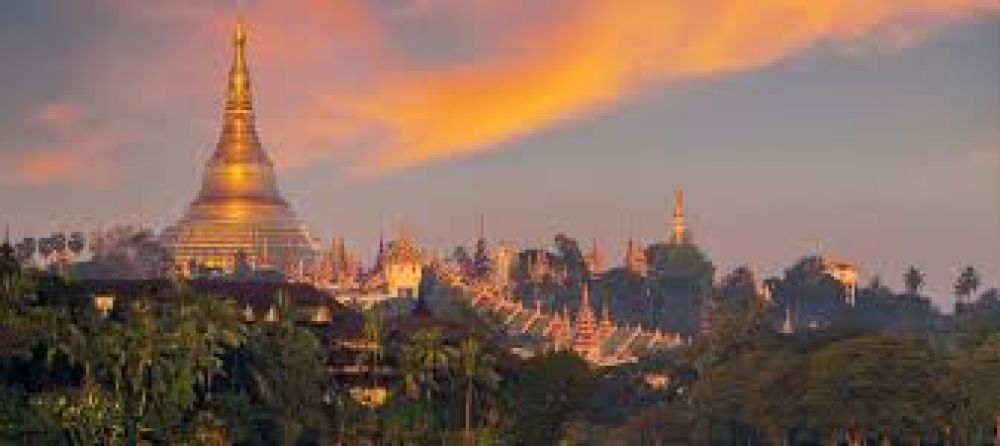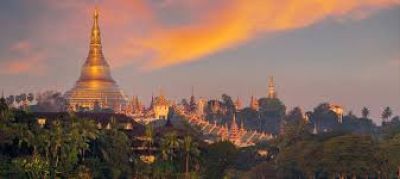

No trip to Yangon is complete without a visit to the Shwedagon Pagoda, Myanmar’s most sacred Buddhist pagoda. The 99-meter-high stupa is plated with gold and adorned with thousands of diamonds, rubies, and other precious stones. The glow of Shwedagon at sunset is a truly awe-inspiring sight. Visitors can walk around the complex, observe locals offering prayers, and even partake in ceremonial rituals. Guides are available to explain the history and significance of the different structures within the complex. Additionally, the pagoda's platform offers panoramic views of Yangon. It's a place of deep cultural and spiritual importance, providing insight into the role of Buddhism in Myanmar.
Bogyoke Aung San Market, also known as Scott Market, is the perfect place to find Myanmar handicrafts, textiles, and jewelry. This colonial-era market houses over 2,000 shops and stalls where tourists can browse for souvenirs such as traditional Burmese clothing, lacquerware, and jade. The market is not just a shopping destination; it's a historical landmark and offers a chance to interact with friendly local vendors. Be sure to negotiate on price to get the best deals. The market is an excellent way for visitors to experience the local trade and craftsmanship, which is an integral part of Yangon's cultural heritage.
A guided walking tour of downtown Yangon reveals the city's fascinating blend of colonial architecture and modern life. As you stroll through the streets, you'll see historic buildings, such as the City Hall and the High Court, with their distinctive colonial-era design. Your guide will provide context on the importance of these structures and the history of the area. The tour also highlights local street food stalls where you can sample Burmese snacks and tea. Walking tours are an intimate way to discover the heart of the city while learning about Yangon's past, present, and future directly from a knowledgeable local guide.
Experience the tranquility of the Yangon River with a sunset cruise that offers spectacular views of the city as the day comes to a close. Board a boat and float past waterfront scenes of daily life accompanied by the calming flow of the river. The cruise provides a unique vantage point to capture the contrast between Yangon's modern skyline and the timeless beauty of its riverside villages. As the sun dips below the horizon, the sky lights up with colors, providing a perfect backdrop for memorable photos. Food and drinks are often available on board, making the cruise a pleasant way to unwind after a day of sightseeing.
Food lovers will relish the opportunity to take a street food tour in Yangon, diving into the flavors and aromas of traditional Burmese cuisine. Starting in bustling street markets, visitors can try local favorites like mohinga (rice noodle and fish soup), palata (a type of flatbread served with a side of curry), and sweet snacks like mont lin ma yar (small round cakes). Experts guide tourists through the food stalls, explaining ingredients and cooking methods. The tour is not only about tasting but learning the cultural significance of each dish. It's an adventure for the palate and a hands-on way to understand the cultural fabric of Myanmar.
Yangon is an excellent destination for mindfulness and meditation. There are several retreat centers where you can learn and practice meditation techniques with experienced instructors. The retreats vary in length and provide different meditation styles, from Vipassana to Metta (loving-kindness meditation). These sessions are conducted in peaceful settings, often surrounded by nature, making it easier to disconnect and focus inward. Participants learn how to apply mindfulness in daily life and leave with a sense of calm and rejuvenation. It's an opportunity to delve into Myanmar's spiritual practices and find personal growth.
Kandawgyi Park, with its huge lake and wooden boardwalk, is a serene escape from Yangon’s bustling streets. It's a popular spot for leisurely strolls, jogging, and enjoying the local flora. Visitors appreciate the well-maintained park's tranquility and the grand view of the Karaweik Palace, a replica of a royal barge that sits on the eastern shore of the lake. The park also features an aquarium and plenty of spaces perfect for picnicking. Occasional cultural performances and festivals held at Kandawgyi add to the attraction's charm. A visit here is a chance to relax and immerse yourself in Yangon's natural beauty.
For an authentic experience of Yangon life, take a ride on the Yangon Circular Railway. This local commuter train circles the city and provides a window into the daily routines of residents. The three-hour-long journey covers about 46 km, passing through urban neighborhoods and rural landscapes. It's a unique way to see Yangon away from the tourist spots while experiencing local transportation. Visitors will see street vendors hopping on and off, selling snacks and goods, and observe relaxed scenes of rural life. It’s both an inexpensive and immersive way to explore and is best enjoyed with an open mind and a sense of adventure.
In the heart of downtown Yangon stands the Sule Pagoda, said to be over 2,500 years old and a central part of local history and politics. This octagonal stupa is not only a place of worship but also a landmark that has witnessed numerous historic events in Myanmar's struggle for independence. The area surrounding the pagoda is alive with daily hustle and bustle, with numerous small shops and street vendors. Inside the pagoda, the atmosphere is one of calm and devotion, with people meditating or offering flowers and incense. Guided tours are available to explain the pagoda's history and significance.
The National Museum of Myanmar offers a comprehensive and fascinating look at the country’s history, culture, and art. Spread across five floors, the museum's exhibits include ancient artifacts, royal regalia, traditional costumes, and a gallery dedicated to the evolution of the Burmese script. The highlight for many is the Lion Throne, a spectacular piece once used by the Burmese kings. Visitors will gain a deeper understanding of Myanmar's heritage through well-curated displays, which include several English descriptions. Whether you're a history buff or simply curious, the National Museum provides a rich educational experience.
